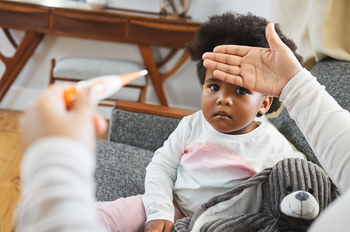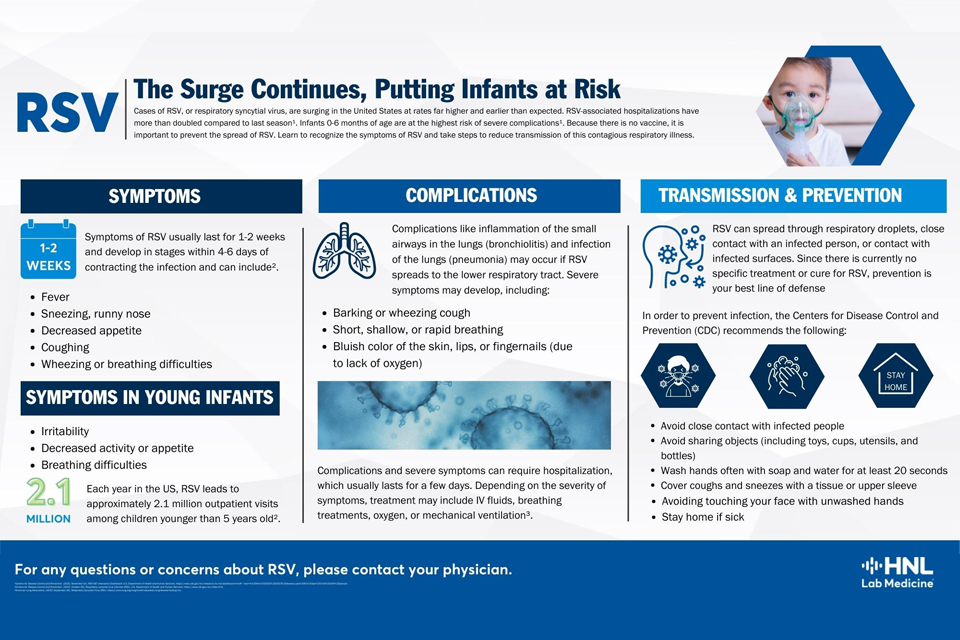RSV Surge Continues, Putting Infants at Risk

Cases of RSV, or respiratory syncytial virus, are surging in the United States at rates far higher and earlier than expected. RSV-associated hospitalizations have more than doubled compared to last season¹. Infants 0-6 months of age are at the highest risk of severe complications¹. Because there is no vaccine, it is important to prevent the spread of RSV. Learn to recognize the symptoms of RSV and take steps to reduce transmission of this contagious respiratory illness.
Symptoms
Symptoms of RSV usually last for 1-2 weeks and develop in stages within 4-6 days of contracting the infection and can include²:
- Fever
- Sneezing, runny nose
- Decreased appetite
- Coughing
- Wheezing or breathing difficulties
Symptoms in Young Infants
Very young infants with RSV may have fewer symptoms, such as²:
- Irritability
- Decreased activity or appetite
- Breathing difficulties
Complications of RSV
Complications like inflammation of the small airways in the lungs (bronchiolitis) and infection of the lungs (pneumonia) may occur if RSV spreads to the lower respiratory tract. Severe symptoms may develop, including:- Barking or wheezing cough
- Short, shallow, or rapid breathing
- Bluish color of the skin, lips, or fingernails (due to lack of oxygen)
Transmission, Treatment & Prevention
RSV can spread through respiratory droplets, close contact with an infected person, or contact with infected surfaces.Since there is currently no specific treatment or cure for RSV, prevention is your best line of defense.
In order to prevent infection, the Centers for Disease Control and Prevention (CDC) recommends the following:
- Avoid close contact with infected people
- Avoid sharing objects (including toys, cups, utensils, and bottles)
- Wash hands often with soap and water for at least 20 seconds
- Cover coughs and sneezes with a tissue or upper sleeve
- Avoiding touching your face with unwashed hands
- Stay home if sick
Protect Yourself and Your Loved Ones from RSV
Although RSV usually leads to mild, cold-like symptoms that resolve in a week or two, some cases may require hospitalization. Infants and young children are particularly at risk. Taking steps to reduce the transmission of RSV can also help prevent infection in others. Be mindful of RSV this season- especially when spending time with infants and young children. To learn even more, visit RSV (Respiratory Syncytial Virus) | CDC.
Download RSV Symptoms Infographic

References
¹Centers for Disease Control and Prevention. (2022, November 03). RSV-NET Interactive Dashboard. U.S. Department of Health and Human Services. https://www.cdc.gov/rsv/research/rsv-net/dashboard.html#:~:text=In%20the%202022%2D2023%20season,was%209.0%20per%20100%2C000%20people .
²Centers for Disease Control and Prevention. (2022, October 20). Respiratory syncytial virus infection (RSV). U.S. Department of Health and Human Services. https://www.cdc.gov/rsv/index.html .
³American Lung Association. (2022, September 06). Respiratory Syncytial Virus (RSV). https://www.lung.org/lung-health-diseases/lung-disease-lookup/rsv .